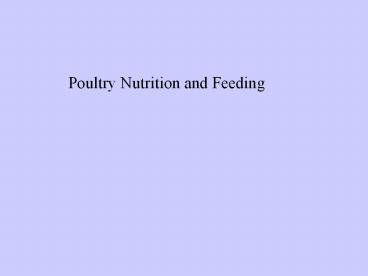Poultry Nutrition and Feeding - PowerPoint PPT Presentation
1 / 28
Title:
Poultry Nutrition and Feeding
Description:
Poultry Nutrition and Feeding Nutrients Carbohydrates and Fats (Energy) Protein and Amino acids Minerals Vitamins Water Carbohydrates and Fats (Energy) Carbohydrates ... – PowerPoint PPT presentation
Number of Views:7471
Avg rating:5.0/5.0
Title: Poultry Nutrition and Feeding
1
Poultry Nutrition and Feeding
2
Nutrients Carbohydrates and Fats
(Energy) Protein and Amino acids Minerals Vitamins
Water
3
- Carbohydrates and Fats (Energy)
- Carbohydrates
- Sugar, starches
- Indigestible fiber (cellulose) not used
- Energy is needed for
- Muscular activity, movement, and keeping warm
- Biochemical energy for maintenance and growth of
tissue - Glucose is metabolized and energy (ATP) is
released - Energy expressed as calories
- Most of feed intake is for calories (about 80 of
the diet) - Fats help make cell membranes
4
Energy Sources Cereal Grains Corn (maize)
worlds most important feed grain Wheat Barley,
oats Sorghums (milo) tannins Millet (pearl
millet, foxtail millet, proso millet) Rice
5
Alternative Energy Sources Cereals and milling
by-products Wheat middlings Rice
screenings Roots and tubers Cassava (manioc)
roots, sweet potatoes, taro, yams Fruits and
by-products Banana and plantain, breadfruit,
dates Miscellaneous Molasses (by-product of
sugar cane industry) Fats (palm oil, coconut
oil, animal fats)
6
Protein Muscle tissue (meat) is protein Amino
acids Building blocks of protein protein
synthesis Essential amino acids Cant be made
by chicken Must be in the diet About 20 of
diet needs to be protein
7
Protein sources Legumes Soybeans or soybean
meal (cooked or heat-treated) Peanut
meal Sunflower, safflower, sesame meals Field
peas, beans (navy, lima, fava)
8
Popular Feed Combination Grains Low in
lysine high in methionine Legumes High in
lysine, low in methionine Corn/soybean diet is
most common Synthetic amino acids Methionine
and lysine often limiting
9
Alternative Protein Sources Cottonseed
meal Coconut meal, palm kernel meal Milling
by-products Corn gluten meal Brewers and
distillers by-products
10
Animal Protein Meals Fishmeal Meat and bone
meal Blood and offal Milk, buttermilk and dairy
by-products (whey)
11
Minerals Part of body Bone Egg
shell Electrolytes function in fluid balance to
maintain concentration gradients Only about
3-4 of diet Macro-Minerals Calcium Phosphorus
Sodium Potassium Chlorine Magnesium Sulfur
12
Calcium and phosphorus must be balanced 2 parts
calcium 1 part available phosphorus Macro-Miner
al Sources Limestone or oyster shell Bone
meal Salt
13
Micromineral (trace minerals) Function as
activators or cofactors of enzymes Iron Iodine Zi
nc Manganese Copper Selenium Molybdenum Chromium
Source Wood ashes may provide trace minerals for
scavenging poultry
14
Vitamins Co-factors of enzymes to catalyze
reactions in the body Less than 1 of the
diet Water-soluble Vitamins (rapidly
excreted) Vitamin C B-Complex Vitamins
Thiamin B1 Pantothenic acid Riboflavin B2
Niacin Pyridoxine B6 Folic
acid Cyanocobalamin B12 Biotin Choline Fat
-soluble Vitamins (can be stored in fatty
tissue) Vitamin A Vitamin E Vitamin D Vitamin K
15
Vitamin Sources Premix Yeast (B-complex
vitamins ) Green fodder (B-complex vitamins,
vitamin A) Alfalfa meal Dairy by-products (whey,
buttermilk) Brewery wastes Animal
by-products Milling by-products (bran, middlings)
16
Alternative feeds Make use of local feed
resources Scavengable Feed Resource Base Table
scraps, harvest wastes Efficient waste disposal
system Forage Seeds Green fodder Legume
plants, tree legumes
17
Live protein Earthworms Insects (fly larvae,
grasshoppers, crickets, termites, bees) Snails
Disease vectors Collect live protein
18
Quality assurance Moldy feed is a
concern Weed seeds Variability
19
Nutritional deficiency diseases Deficiency Symp
tom Riboflavin Curled toe paralysis Niacin
Slipped tendon (perosis) Calcium or
phosphorus Rickets Iron Anemia Iodine
Goiter
20
Feed is the major cost of production Full-feeding
recommended Weight of the feed required is at
least twice the expected market weight of the
birds
21
Water Chickens are 85 water Death in one day
without water in hot weather Water should be
clean and cool 100 broilers drink 28.8 liters on
a 21 C day (7.6 gallons)
(70 F) 100 broilers drink 47.3 liters on a 32 C
day (12.5 gallons) (90 F)
22
Non-nutritive feed additives Medications
antibiotics, anticoccidials, insecticides,
wormers Preservatives antifungal Pigments to
add color to skin and egg yolks
23
- Sources of poultry feeds
- Prepare feed from local grain and feedstuffs
- Prepare feed from local grains/protein sources
- and imported concentrates
- Commercial feed
24
Feeding systems Scavenging birds Supplement
diet Range birds get protein and vitamins from
green forage Supplement with energy and
minerals More supplementation if dry, fibrous
vegetation Feeding a concentrate supplement with
cheap, bulky feed
25
Pasture management Irrigate if
possible Alfalfa, clover, local
forages Self-feeding vs. cut and carry
26
Formulas for Feed Rations No simple answer Many
different recipes are possible Nutrient
requirements vary according to stage of
production Starter, grower, finisher Type of
poultry Broiler, layer, breeder, turkey, duck,
geese Climate Ingredients vary in nutrient
content Large manufacturers change formulation
daily or weekly depending on price of
ingredients
27
Free-Choice Cafeteria Feeding Feed in 3 separate
containers Energy-rich Protein-rich Mineral-ric
h Birds can balance own diet
28
Feed Mixing Gather feed ingredients Grind
ingredients Small ingredients need to be
especially well-mixed Mix on flat surface or use
concrete mixer Large manufacturers use
mechanical mixers Produce mash, crumbles, or
pellets Storage probably less than 2 months































